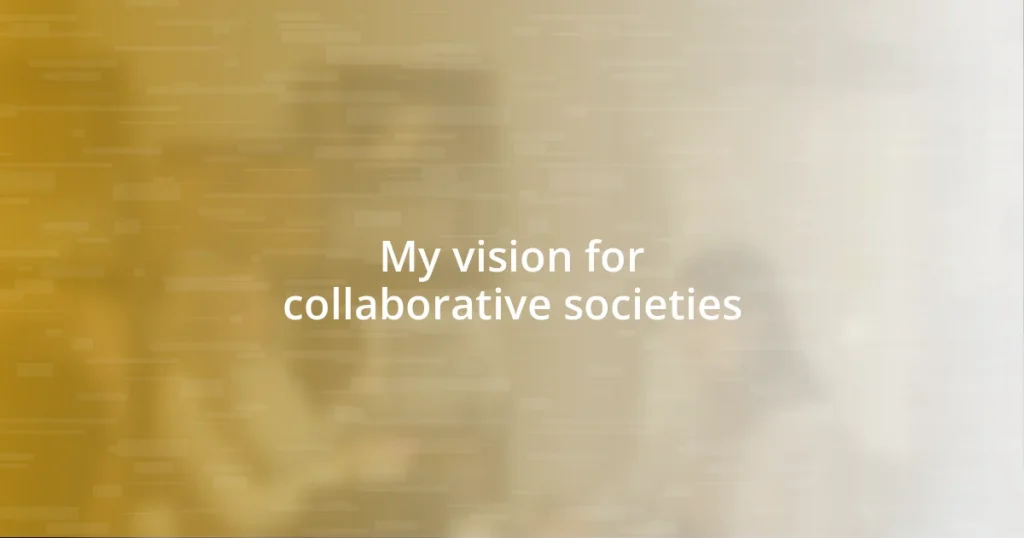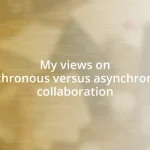Key takeaways:
- Collaborative societies thrive on trust, open communication, and shared goals, fostering creativity and a sense of belonging among members.
- Key principles for effective collaboration include trust, open communication, inclusivity, shared goals, and accountability, which transform challenges into growth opportunities.
- Beneficial strategies for building collaboration include regular check-ins, utilizing collaborative tools, and fostering a culture of appreciation, enhancing engagement and communal success.
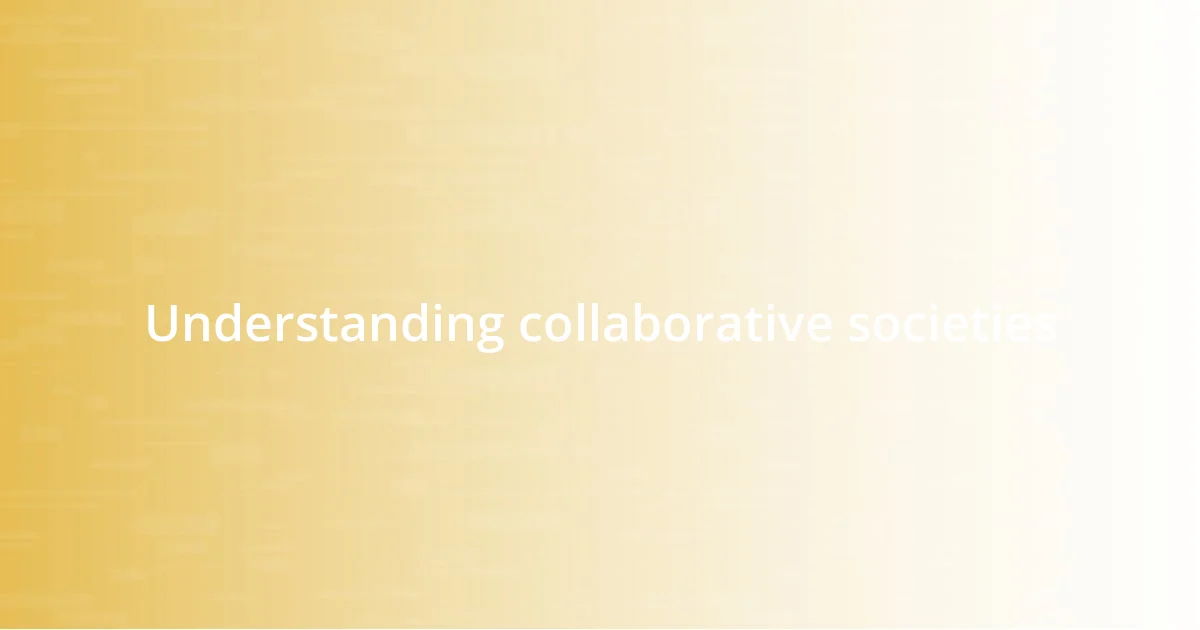
Understanding collaborative societies
Collaborative societies thrive on the shared goals and values of their members. I remember a community project I joined some years back where we transformed a neglected park into a vibrant space for everyone. The sheer joy of working alongside my neighbors, pooling our skills, and witnessing tangible results was a testament to the power of collaboration.
At the heart of these societies is trust and open communication. Have you ever noticed how ideas tend to flow more freely in groups where members feel safe to share? I’ve experienced this firsthand in brainstorming sessions, where the simple act of listening can spark innovative solutions that no one could have imagined independently. It’s amazing how much creativity can emerge when we focus on collaboration rather than competition.
Moreover, the impact of collaborative societies extends beyond immediate projects; they create a sense of belonging and purpose. I often find myself reflecting on how interconnected our lives are, and it reminds me of the warmth I felt at our local community gatherings. Each encounter reinforces the idea that together, we can build something greater than ourselves, forging bonds that uplift not only individuals but entire communities.
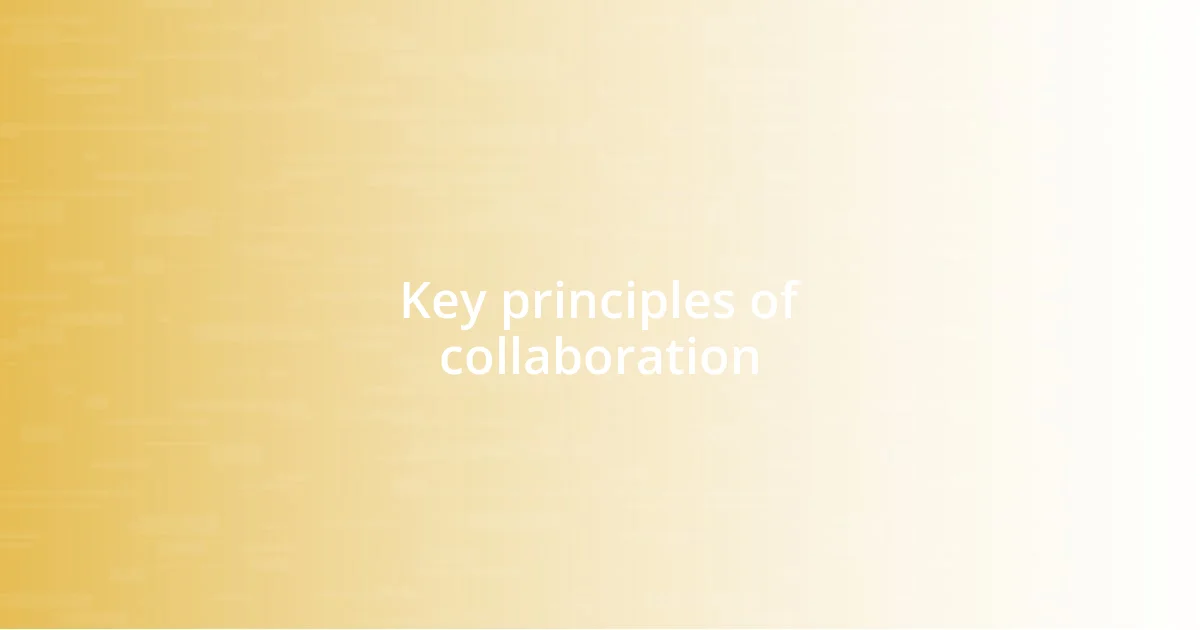
Key principles of collaboration
Collaboration is rooted in mutual respect and shared responsibility. I once participated in a volunteer initiative where we organized a community clean-up. Everyone brought different skills—some painted, others organized supplies. The feeling of collective ownership made the event not just productive but exhilarating, reminding me that when people feel valued, they’ll go the extra mile.
Here are some key principles that underline effective collaboration:
- Trust: Establishing trust allows members to share ideas without fear of judgment.
- Open communication: Encouraging transparency ensures everyone’s voice is heard.
- Inclusivity: Valuing diverse perspectives fosters creativity and innovation.
- Shared goals: Aligning around common objectives enhances collaboration.
- Accountability: Taking responsibility for one’s contributions strengthens the group dynamic.
I’ve learned that when these principles are in play, the collective energy transforms challenges into opportunities for growth. Observing how each person’s unique input contributes to a larger vision is truly inspiring.
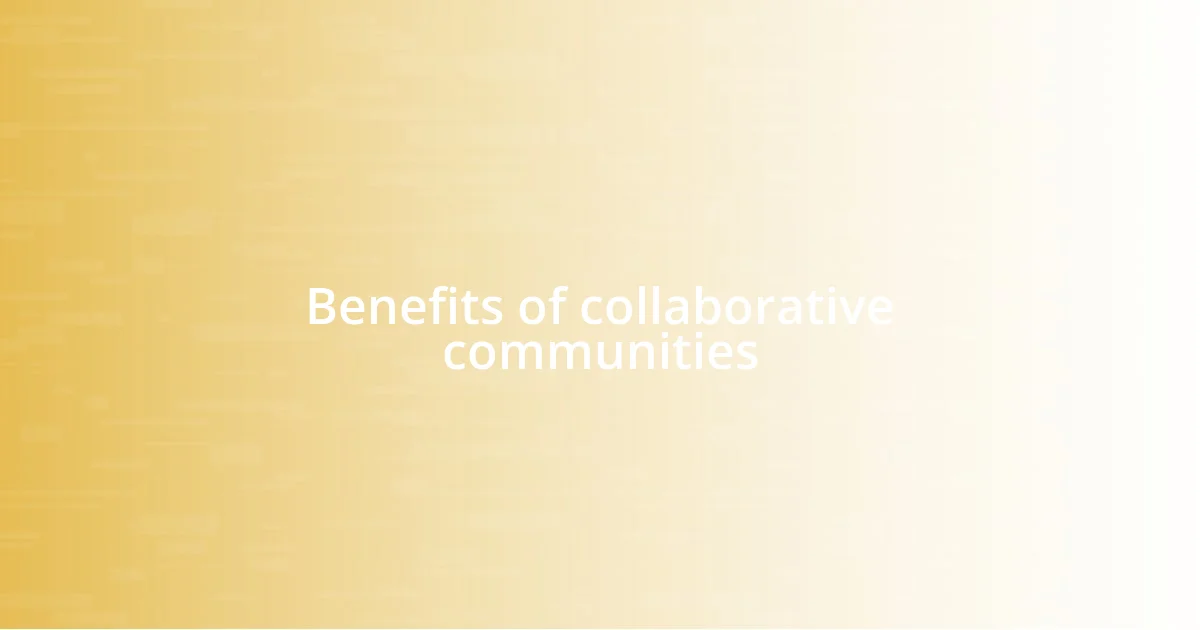
Benefits of collaborative communities
Collaborative communities bring a multitude of benefits to their members. For instance, the diversity of skills and perspectives often leads to innovative solutions that I’ve personally witnessed in community initiatives. Just last summer, during a neighborhood food drive, I saw how someone’s knack for organization perfectly complemented another person’s cooking skills. Together, they created not only an efficient event but also delicious meals that fed hundreds. It’s a vivid reminder that collaboration amplifies our strengths.
Another significant advantage is the emotional support that these communities foster. Being part of a tightly-knit group has provided me with a sense of security during challenging times. When I faced a personal hurdle, my neighbors rallied around me, offering encouragement and assistance. This level of support cultivates resilience and promotes mental well-being, transforming ordinary neighborhoods into emotional lifelines.
Moreover, collaborative communities enhance social capital. They create networks where people can share resources and knowledge. I’ve learned new skills just by conversing with my neighbors during community workshops. Such interactions not only enrich our personal lives but also contribute to a thriving community. It’s fascinating how these connections can lead to new opportunities, often in unexpected ways.
| Benefit | Description |
|---|---|
| Innovation | Diverse skills combine to create unique solutions. |
| Emotional Support | Strong networks provide encouragement and resilience. |
| Social Capital | Resources and knowledge are shared, enhancing opportunities. |
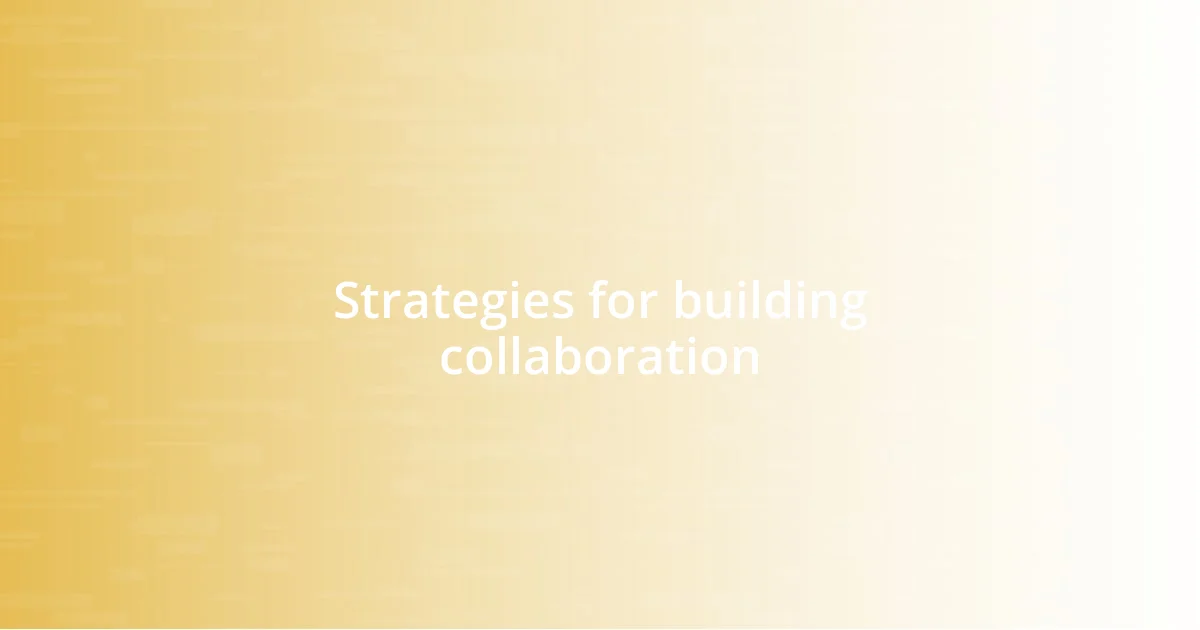
Strategies for building collaboration
Creating effective collaboration isn’t just about putting people together; it requires intentional strategies. One approach I’ve found beneficial is establishing regular check-ins among team members. During a community project I was involved in, we made it a point to gather weekly. These sessions became a space not just for progress updates, but for sharing concerns and celebrating small wins. Have you ever noticed how much more connected you feel when you know others share your struggles and achievements? It truly builds a sense of belonging.
Another strategy involves setting up collaborative tools and platforms to facilitate communication. I’ve often utilized shared digital spaces, like project management apps, where everyone can contribute their ideas and updates. This accessibility encourages participation and accountability. I remember feeling invigorated when a quiet team member finally shared an innovative idea that transformed our approach. Have you considered how technology can bridge gaps in collaboration in your own experiences?
Lastly, fostering a culture of appreciation can significantly enhance collaboration. I’ve seen firsthand how expressing gratitude for even the smallest contributions can elevate the morale of a group. In one instance, after a community garden project was completed, we held a tiny celebration to acknowledge everyone’s input. The joy and pride in that moment were palpable, reinforcing our commitment to future endeavors. Isn’t it fascinating how a simple “thank you” can create such a ripple effect in collaboration?
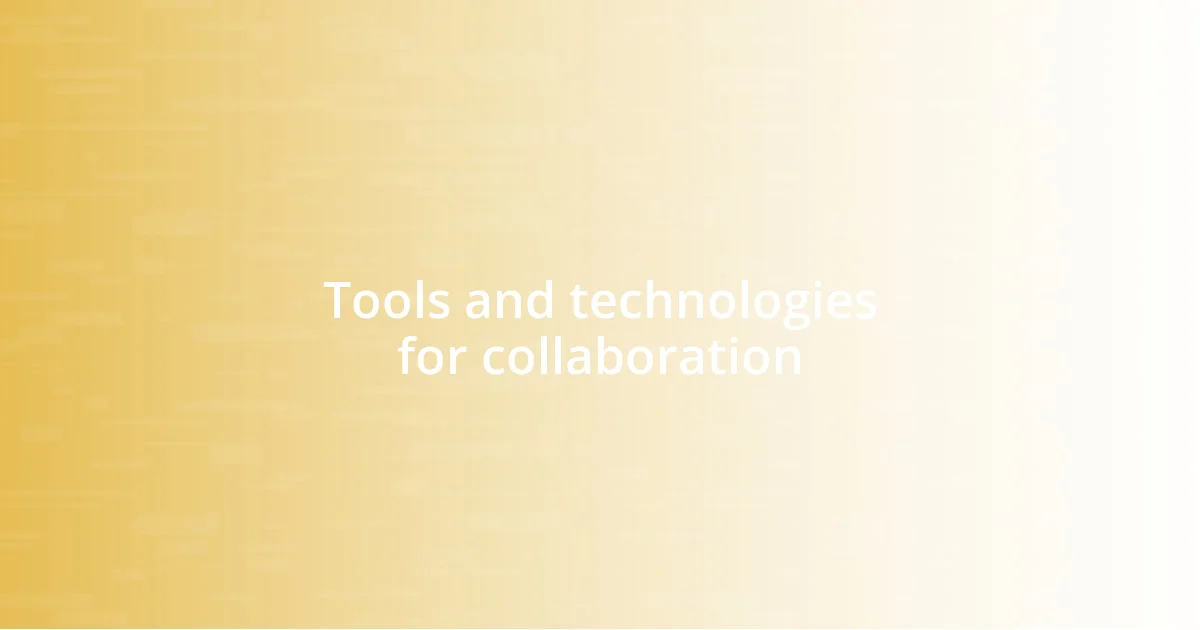
Tools and technologies for collaboration
Tools and technologies play a crucial role in fostering collaboration within societies. I’ve found that utilizing collaborative software, like Slack or Trello, can seamlessly connect team members, regardless of their physical location. For example, during a volunteer project in my city, we relied heavily on a shared Trello board to track tasks and deadlines. It felt electric to see everyone’s contributions in real-time, sparking conversations that often led to new ideas.
Video conferencing tools have also become cornerstones of collaboration. I remember the first time my community group adapted to virtual meetings; it was an eye-opener. At first, I was skeptical about how effective discussions would be over screens, but we embraced the platform, and it turned out to be surprisingly effective. Isn’t it intriguing how technology can change the way we connect? With features like breakout rooms, we could brainstorm in smaller groups, allowing quieter voices to shine through in ways they sometimes wouldn’t in person.
Lastly, employing shared digital workspaces can break down barriers to collaboration. One memorable experience I had was when we created a communal Google Drive for a local arts project. As everyone contributed their designs and concepts, it fostered an environment of creativity and openness. I could sense the excitement as we exchanged feedback right on the documents. It made me realize that when technology is harnessed properly, every participant feels valued and inspired to contribute. Have you seen similar results in your own collaborative efforts?
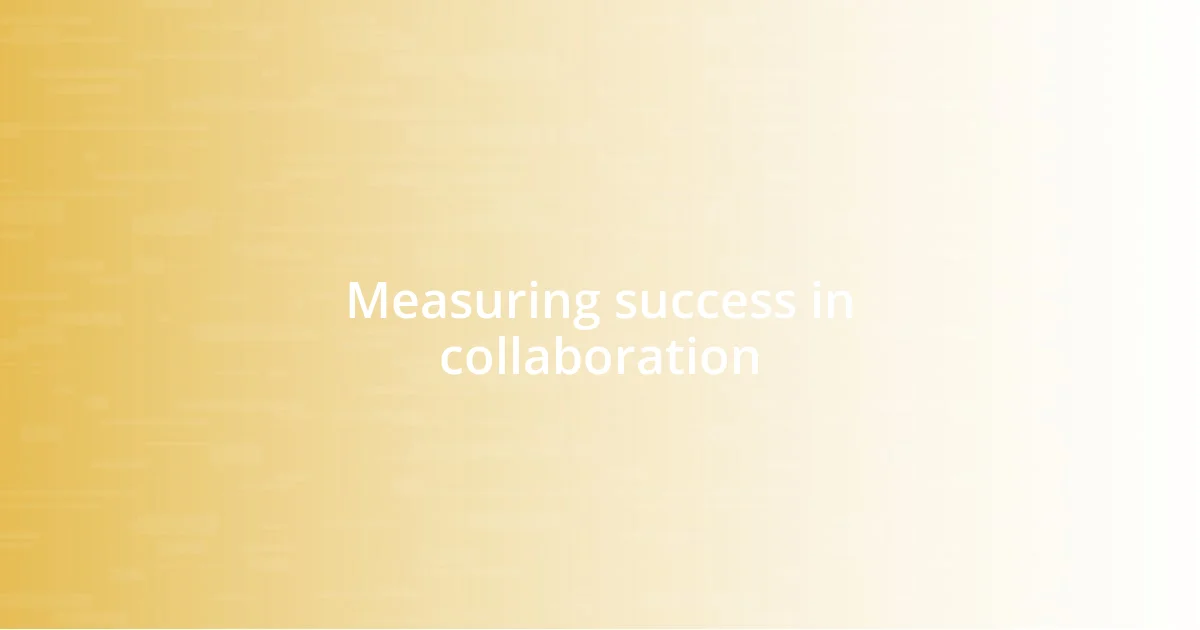
Measuring success in collaboration
Measuring success in collaboration can be quite nuanced. One key way I gauge this is through the quality of relationships built among participants. When I recall a recent neighborhood initiative, we established a feedback loop to evaluate how connected team members felt. The responses revealed that many felt a stronger bond, which, to me, indicated that our collaboration wasn’t just about tasks, but connections.
Another indicator is the achievement of goals that were set collaboratively. In a community art project I was part of, we defined clear objectives together, making sure everyone’s voice was heard. Reflecting on our progress, I noticed how each milestone reached was celebrated not just as a personal win, but as a collective triumph. I often ponder—when we achieve together, how does that shared success impact our motivation for future collaborations?
Additionally, observing engagement levels during collaborative efforts can tell you a lot about success. I remember a workshop where we encouraged participants to pitch their ideas openly. The energy in the room was palpable, and it was fascinating to witness individuals who usually held back become vocal and enthusiastic. This level of engagement is a strong sign that collaboration is flourishing. Have you experienced moments where engagement shifted the dynamic of your group? Those are moments that truly define success.
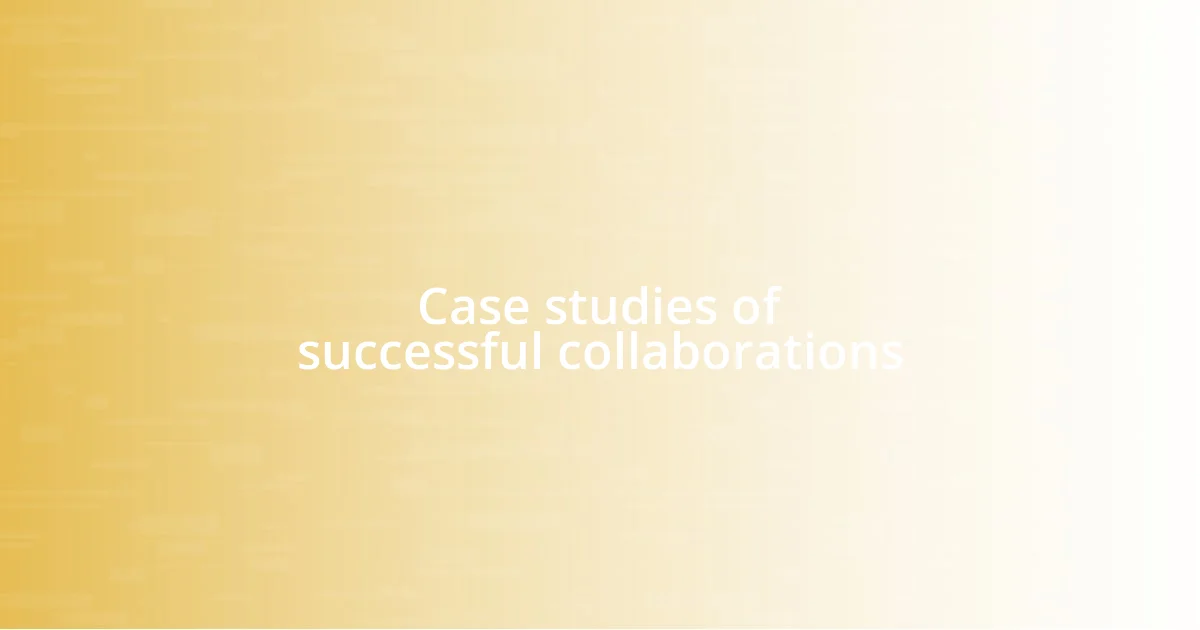
Case studies of successful collaborations
One of the most memorable examples of successful collaboration I witnessed was during a community clean-up event. We partnered with local businesses, and each had a unique role in the project. I still remember how excited the children were to help, equipped with gloves and trash bags. Watching everyone come together, regardless of age or background, brought a real sense of unity. How often do we see such diverse groups connecting over a simple goal?
In another instance, a food bank initiative in my town utilized a collaborative network that included local farms, grocery stores, and volunteers. I was lucky enough to coordinate the outreach efforts, and it was fascinating to see how each partner added value to the project. Farmers donated fresh produce, while stores provided packaging materials. When we delivered meals to families in need, I could feel the gratitude in every thank you we received. Isn’t it amazing how a shared purpose can spark such generosity?
Lastly, I participated in a virtual book club that expanded into a cross-community literary festival. Each meeting, we’d choose a different theme, and volunteers would take on planning roles that suited their passions. I distinctly remember the excitement as we transformed ideas into action. The festival brought in authors, artists, and performers, enriching our communities. Reflecting on it, I can’t help but wonder—what if every community embraced creativity like that? The potential for collaboration is truly limitless.










